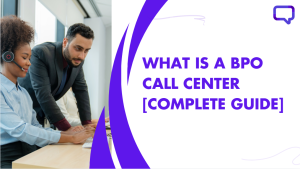While most organizations emphasize the importance of good external customer service, the importance of internal customer service often goes unnoticed. Internal customer service refers to the interactions and services between the different departments of a company. When there are interdepartmental bottlenecks, it can lead to employee demoralization, decreased productivity, poor teamwork and collaboration, and low quality of external customer service. In this blog, learn 10 key strategies to improve the internal customer service of your organization and ensure seamless interaction between the various departments of your company.
Table of Contents
Internal customer service is just as important as external customer service, if not more.
Unless you’ve got happy, satisfied employees, you won’t have happy, satisfied customers.
Smart, successful companies know this full that an employee’s negative state of mind has a direct impact on external customer service.
They make sure to prioritize enhancing their internal customer service when mapping out the customer experience strategy.
Knowing how to improve internal customer service is crucial in that regard for the ultimate success of any firm.
But first, let’s understand who are internal customers.
Who are Internal Customers
Internal customers are full-time employees, part-time employees, and even contractors.
These customers work for the organization and interact with the rest of the internal customers or the business stakeholders.
For example, an HR manager is the internal customer of the IT department if they rely on the IT team to maintain the HR information system or to equip new hires with necessary hardware and software.
Another example of an internal customer could be the sales team. They are dependent on product development to create products that meet customer needs.
Internal customer service refers to the interactions among these different internal customers within an organization as seen in the examples above.
Difference between Internal and External Customers
| Internal Customers | External Customers | |
|---|---|---|
Definition | Individuals or departments within an organization who rely on services, information, or products from other individuals or departments within the same organization. | Individuals or entities outside the organization who purchase or use its products or services. |
Interaction | Interaction occurs within the organization, often involving different departments or teams. | Interaction occurs between the organization and an external entity or individual. |
Purpose | The purpose is to facilitate the smooth running of the organization, ensuring that all departments have what they need to do their jobs effectively. | The purpose is to satisfy their needs and wants, generating revenue for the organization. |
Service Delivery | Service delivery is often indirect and may not be visible to external customers. | Service delivery is usually direct and is the main point of contact with the organization for the customer. |
Feedback | Feedback mechanisms are often internal surveys or interdepartmental meetings. Feedback may be less formal and more immediate, but can sometimes be overlooked. | Feedback mechanisms can include surveys, reviews, and complaints. Feedback from external customers tends to be formal and is often a key focus for improvement. |
Recommended: The Future of Customer Service and 5 Rising Customer Expectations
10 Ways to Improve Internal Customer Service
Promote a Service-Oriented Culture
The first thing to do when strengthening interdepartmental service is to promote a service-oriented culture.
Every department needs to realize that they’re part of a bigger picture and they need to see themselves as both the provider and recipient of services.
The realization that all internal entities and individuals are interconnected enhances cooperation, improves teamwork, and boosts the overall performance of each internal customer.
Implement Feedback Mechanisms
Regular feedback is crucial to understand the effectiveness of your internal service.
Implement mechanisms, like internal surveys or suggestion boxes, to gather insights about your internal service delivery.
The purpose of implementing feedback mechanisms is to capture insights from the internal customers (employees) about their experiences, suggestions, or concerns.
This feedback can then be analyzed and used to make informed decisions about improving internal customer service or other aspects of the organization’s operations.
It helps ensure that the internal processes are working effectively and any issues are identified and addressed promptly.
Invest in Employee Training
Ongoing training programs can significantly improve internal customer service.
Train your employees throughout – from onboarding to skills development, from soft skills training to product or service training, and to process and compliance training.
Furthermore, technical skills, communication techniques, and conflict resolution can also make a big difference in how they interact and serve each other.
Remember, well-trained employees are more confident and efficient in their roles.
Set up a Reward System
Everyone appreciates being recognized for their hard work.
Establish a system to acknowledge and reward employees who go above and beyond in providing excellent internal service.
This not only motivates the employees but also sets a standard for others to strive for.
Examples of setting up reward systems for employees include having an employee of the month, unexpected or spot bonuses, team-based rewards, and professional development opportunities.
You can also use feedback mechanisms such as NPS surveys.
Set Service Standards
Creating service standards involves defining the level of service you expect your employees to deliver, both to external customers and internally to their colleagues.
Create service standards to improve internal customer service. An example of this includes holding employees accountable for not responding to a colleague’s request within a certain frame of time.
These standards serve as a guiding principle for your team, helping to ensure consistency and high quality in all interactions.
Streamline Processes
Simplifying and improving the workflows and procedures within an organization improves internal customer service massively.
The aim is to eliminate any unnecessary steps, reduce inefficiencies, and make processes faster, easier, and more effective.
For example, an organization’s marketing department might be planning to launch a new product.
They need important product information and supporting materials from the product development team.
However, due to poor communication channels, the product development team is slow to respond and doesn’t deliver the requested information on time.
This delay is a bottleneck in good internal customer service.
The marketing department cannot proceed with its scheduled plan, which affects its preparation and planning, potentially resulting in missed opportunities or delayed product launches.
Leverage Technology
Employ the latest technology in your internal functions to make them run more smoothly.
This technology can include using collaboration tools such as Slack, Microsoft Teams, or Google Workspace.
By means of such tools, employees will be able to message instantly, share files, have video conferences, and develop more efficient interactions.
Furthermore, CRM tools are not only suitable for use with external customers but also with internal customers as well.
Other technologies include arranging for online learning platforms like Moodle or Coursera.
Promote Team Building
The foundation of effective internal customer service is strong interdepartmental relationships.
Team building activities serve as a powerful tool in forging these relationships.
They provide an opportunity for employees to interact beyond the confines of their roles and responsibilities, fostering understanding, empathy, and a sense of camaraderie.
Such activities might include workshops, retreats, or even simple team lunches.
As a result, communication barriers are broken down, leading to more efficient information exchange and problem-solving.
In turn, this improved collaboration boosts the quality of internal customer service, creating an environment where departments work in unison towards organizational goals.
Prioritize Problem Resolution
Even in the most harmonious environments, there will be issues.
The important thing is how these conflicts are addressed.
By prioritizing swift and effective problem resolution, an organization can prevent small miscommunications from escalating into larger issues.
This involves encouraging a culture of openness where employees feel comfortable raising concerns, as well as implementing systematic approaches to conflict resolution.
Quick resolution not only amends immediate issues but also signals to employees that their concerns are valued.
This can enhance trust and goodwill among team members, fostering a positive and productive work environment that naturally elevates the level of internal customer service.
Commit to Continuous Improvement
The pursuit of excellence in internal customer service should be viewed as an ongoing journey, not a destination.
Organizations should establish a culture of continuous improvement where feedback is regularly provided and applied, and where service processes are routinely reviewed and enhanced.
This might involve regular training sessions, feedback surveys, or process audits. The key is maintaining a proactive, rather than reactive, approach.
By continuously looking for ways to improve, organizations remain dynamic, flexible, and ready to adapt to changing needs or circumstances.
This fosters a culture where high-quality internal customer service is not just expected but ingrained in the very fabric of the organization’s operations.
Conclusion – How to Improve Internal Customer Service
So, as you’ve learned above, giving a boost to your internal customer service isn’t just a one-and-done kind of deal.
It takes a good amount of effort, time, and a whole lot of commitment from everyone involved. But in the end, it’s all worth it!
Your organization might be focusing loads on external customer service (and of course, that’s very important too), but don’t forget the engine behind the doors.
Start off with team building, mix in a healthy dose of prioritizing problem-solving, and never forget to be on the lookout for ways to do things better.
All this comes together to create a workplace where everyone’s chipping in, enjoying their work, and are all in it together.
Think of your organization like a jigsaw puzzle – when all the pieces fit together just right, you get a beautiful picture. That’s what you ought to be aiming for.
Every department, every person plays a critical role, and getting everyone to work together smoothly is what internal customer service is all about.

![What is Shrinkage in the Call Center [Updated 2025]](https://www.hiredsupport.com/wp-content/uploads/2025/04/What-is-Shrinkage-in-Call-Center-1-300x169.png)
